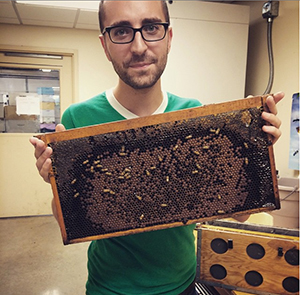
This is the twenty-fourth “Notes from the Lab,” which means readers have either been enjoying or suffering through this column for two years. Perhaps a bit of both. Can you remember the columns you really liked and the ones you really didn’t? If you can, that’s due to valence encoding of your brain’s neurons, which distinguishes between positive and negative experiences.
Valence has been studied extensively in animals that have relatively large brains, such as birds and mice and other vertebrates. These studies show that discrete neural circuits within the brain encode information about positive vs. negative experiences. In other words, completely different sets of neurons are used to remember good times vs. bad times.
But what about insects such as honey bees? Can they remember good times and bad times? And if so, do their tiny brains still have different sets of neurons that are used to remember those good times and bad times? This is the topic highlighted in “Valence of social information is encoded in different subpopulations of mushroom body Kenyon cells in the honeybee brain,” written by Ian Traniello and colleagues and published in the journal Proceedings of the Royal Society of London B [286:20190901 (2019)].
Traniello and colleagues’ study was motivated by one big (actually small) observation. Honey bee brains are tiny. But anyone who’s worked with bees knows that despite their small size, they’re really smart. As highly social organisms, they communicate quite efficiently to find food sources or a new place to build their nest, and they have a well-orchestrated division of labor to feed their offspring or to find and eliminate sick brood. Their complex and rapid pheromonal communication is exemplified by their ability to quickly alert each other and attack an intruder as a group. No one who’s accidentally handled their bees a bit too roughly can disagree with that last point, I’m sure.
But as smart as honey bees are, there’s only so much real estate in their tiny brains to encode information. So, you might expect they’ve evolved to be pre-programmed robots that can’t afford to devote precious neurons to unique memories. Alternatively, because they routinely navigate complex social interactions and a dangerous world, perhaps honey bees have evolved the ability to store unique memories. If so, they might be more efficient at tapping into previously important context-specific information and therefore make better decisions in the future.
To understand whether honey bees can store memories, and if so, how efficiently those memories are stored, Traniello and colleagues used a simple but elegant bioassay, then did some fantastic gene expression work. Specifically, they exposed 7-day-old adult bees to a “good” experience: nursing a queen larva as a typical nurse bee would in her colony. Another set of 7-day-old adult bees were exposed to a “bad” experience: recognizing and attacking an intruder as a typical guard bee would. Each set of trials included a control (7-day-old bees exposed to an inanimate object), which always resulted in ambivalent bees compared to the bees experiencing the “good” and “bad” stuff. The bees were then left alone for 15 minutes to allow expression of two immediate early genes (IEGs) to develop. These IEGs are an organism’s first response to a stimulus and set the stage for the full genomic response. In other words, IEGs are a bit like the first domino to tip over — they trigger the whole future series of events to occur, with the full set of dominoes representing an organism’s response to its environment.
The two IEGs that Traniello and colleagues observed were known to “turn on” their expression following a positive or negative experience, and it was already suspected they might play a role in activating networks of genes that form good or bad ….


